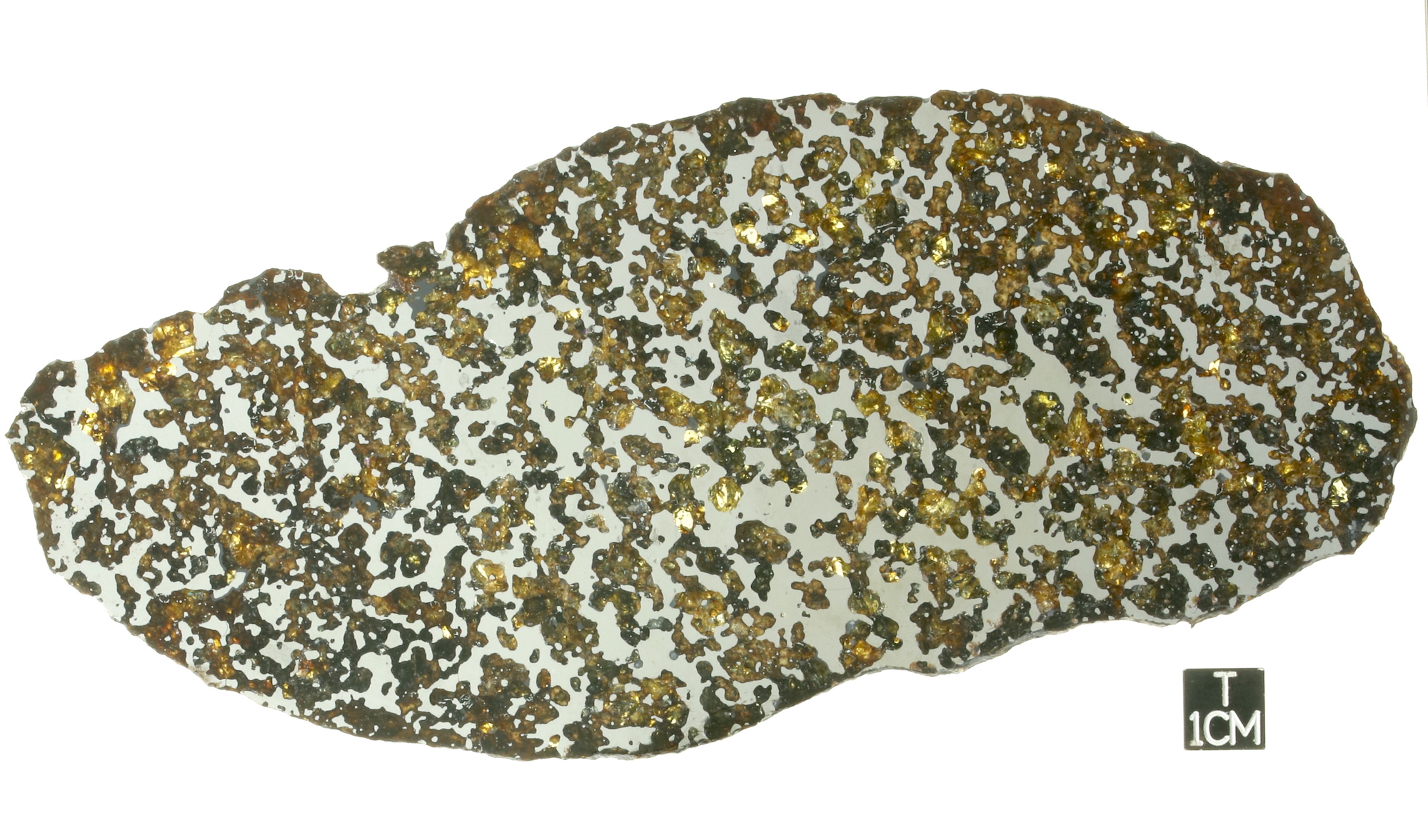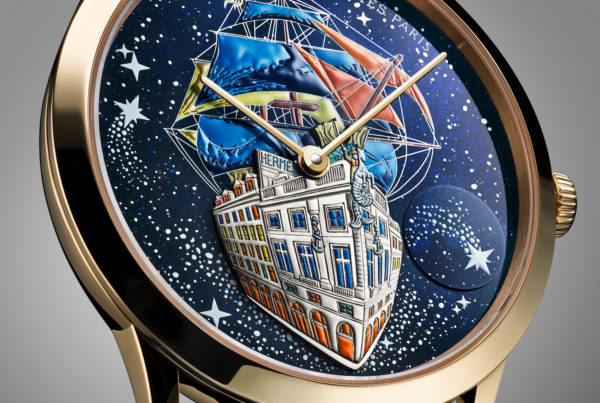Cosmopolis, the time of the stars
On 21 September this year, Jean-Marie Schaller, owner & creative director of the Louis Moinet brand, presented a watch called Cosmopolis whose hours are indicated by meteorites. This timepiece has 12 of them, which earned it a place in the Guinness World Records™. This model is a summary of the history of our solar system and reminds us of our place in the universe: tiny. Isabelle Cerboneschi

“Meteorites represent the origin of the universe and there is a purity in these small fragments that is very touching,” points out Jean-Marie Schaller, CEO & creative director of the Louis Moinet brand. Cosmopolis, his latest creation, also reflects on the origin of the universe and our relationship with time. But not only that: this timepiece is a direct reference to the brand’s history.
“The initial impetus for creating this watch came from the history of Louis Moinet,” he explains. “Micaela (Bartolucci, his wife) and I started the Louis Moinet adventure 25 years ago. We were attracted by the name, which had fallen into oblivion. What remained was an eight-page obituary written by a friend of Louis Moinet, who claimed that he was the greatest of all watchmakers. So I did some research and discovered that he had invented not only the chronograph, but also high frequency, and that his clients included some of the most important people of his time! This man had three passions: the arts, astronomy and watchmaking. So naturally, this attraction to astronomy led us to use meteorites in Louis Moinet watches”.

Before talking about meteorites and looking at what makes the Cosmopolis so special, let’s look back at these two assertions: Louis Moinet as the inventor of the chronograph and high frequency. For a long time, watchmaking history considered that the first chronograph was invented by Nicolas Rieussec in 1822, who used ink to mark the passage of time. That was until the reappearance in 2013 of an extraordinary timepiece that turned all certainties on their head: the very first chronograph capable of calculating one sixtieth of a second! Designed between 1815 and 1816, this pocket watch bears the signature of Louis Moinet on the dial. The watchmaker called it a « Compteur de Tierces » (third timer), because at the time, one sixtieth of a second was called a third. This chronograph oscillates at 30 Hz, a frequency that was not mastered by the watchmaking industry until around two centuries later!
The most common frequency used for mechanical watches is 4 Hz, or 28,800 vibrations per hour. In 2017, Zenith launched its Defy El Primero 21 model, equipped with two independent movements. The first, which displays the hours and minutes, beats at 36,000 vibrations per hour, or 5 Hz, the frequency of the famous El Primero. The second is dedicated to the chronograph function, which displays 1/100th of a second. It operates for only 50 minutes when fully wound, but its balance oscillates at a frequency of 360,000 vibrations per hour, or 50 Hz. With his watch, whose balance oscillates at 30 Hz, Louis Moinet, who had designed it to measure the passage of the stars, was two centuries ahead of his time!
Jean-Marie Schaller did not choose to place twelve meteorites on his dial for the sake of expediency. He has been collecting them for twenty years and buys his supplies from meteorite hunter and dealer Luc Labenne. This former doctor turned meteorite hunter has been scouring the world’s deserts in search of extraterrestrial rocks for almost 30 years. It is to this world-renowned expert that watchmakers and jewellers turn to buy exceptional pieces that will become jewellery or watch dials. “The first one I bought from him was a moon meteorite, and I have to admit I cried when he gave it to me,” he explains. “You look at the moon, it’s 360,000 km away and you have a fragment of it in your hand”. Jean-Marie Schaller’s fondness for meteorites is not only linked to their rarity, but also to their beauty. “Have you ever seen a pallasite (a meteorite composed of olivine crystals embedded in an iron matrix)? It’s magnificent! It’s as if a creator had made art out of a raw material”, he confides.

“Choosing these meteorites was like creating a planetary system inside the watch. We entrusted their cutting to Daniel Haas, a specialist and craftsman in semi-precious stones”, he continues. The watch was designed by his son, Nathanaël Schaller. “The challenge was to place as many varieties of meteorite as possible in the watch: but how to arrange them so that it was harmonious? There are twelve meteorites and twelve hours. If you look at the dial of this piece, between each gap separating the meteorite pellets are the hour markers. The gradation stops at the tourbillon. We placed a black chondrite at the back of the tourbillon cage and in the centre, a lunar meteorite, because the moon makes us dream. I wanted the result to be pure. I trained as a jeweller and the meteorites are held in a closed setting. They give this watch a museum-like feel,” explains Nathanaël Schaller. In fact, this watch has been awarded the title of “Most meteorite inserts in a watch” by Guinness World Records™.

On the evening of the presentation, among the guests was Luc Labenne, the famous star hunter and the man who has been selling his meteorites to Jean-Luc Schaller for twenty years. It was the perfect opportunity to find out more about some of the rare fragments that adorn the Cosmopolis. “Each of the twelve meteorites has a different story: of course there’s one from Mars and another from the moon, but there’s also a meteorite that I really like called Erg Chech 002. It’s the oldest rock in the solar system. When I first received photos of it from the people who had found it, I wasn’t sure it was a meteorite: it has unusual large chartreuse green crystals. But when the scientists analysed it, they realised that not only was it a meteorite, but it was the oldest of them all! It’s 4.567 billion years old, which means it’s a piece of protoplanet that’s older than the Earth”.

Cosmopolis features a number of iconic meteorites. On its dial, you can also see a piece of the Allende, which fell in Mexico. “It has very old inclusions that formed at the beginning of the solar system, but in terms of age, it has been dethroned by the Erg Chech. We should also mention Aguas Zarcas, which fell in Costa Rica and is fascinating. It contains amino acids and is one of those rare meteorites that contains around 15% water. Scientists believe that they were very abundant at the beginning of the formation of the solar system and that 20% of the water on Earth would have been brought by this type of meteorite. I forgot to mention Sahara 97093, which contains microdiamonds measuring between 20 and 100 microns. They were formed during supernova explosions, which contain a lot of carbon. It was during the explosion that diamonds were formed.”
And when you listen to the star hunter tell the story of each meteorite set on the dial of the Cosmopolis, you realise that this watch retraces a part of the history of the solar system and that of humanity…

















